 |
CRT Primer
|
Updated: July 2006 |
Barco
Barco projectors are made in Belgium,
and are long known in the pro video
industry as a very high end of
projectors. I understand that Barco has
recently archived a lot of
specifications of discontinued models on
their website. Barco is still one of two
or three manufacturers making CRT
projectors.
Barco started with video projectors
around 1983-1984 with the Barco Vision,
Barco Data and Vstar lines. I understand
that the Vstar models were made
specifically for the airline industry
and the all of the projectors that I
have seen from this era have weak tubes
and usually have numerous circuit
problems due to the age. I do not
actively sell projectors that are this
old, although I do have the service
manuals and some parts for these sets.
Barco then came out with the Barco 400
and Barco 600 video projectors. The 400
and 600 are very similar in design and
performance. They use 7” SD-187 Sony
tubes with ES focus, have analog
convergence, and scan to 64 Khz with 600
lumens light output. Thousands have been
sold, and many are on the surplus
market.
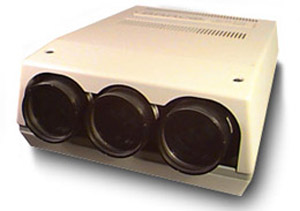
Barco 600
These projectors must be used in
conjunction with either a little plug in
controller module on the back of the
projector, or with a Barco RCVDS 4
switcher unit that acts as a video
selector and video to RGB decoder. Note
that these two projectors usually only
have the RGB inputs working despite the
fact that they have video input
connectors on the projector.
The video
card was an option on these sets, and
hardly any of the sets I get in have had
this video card installed. Also, most of
the surplus projectors do not come with
the plug in controller or with the RCVDS
4 unit, so you may end up needing more
components before you get a watchable
picture.
Barco 1000, 1001, and 1500: These
are a series of 9” analog convergence
projectors that Barco came out
with from about 1989 to 1993. All very
similar to the Barco 600 chassis, but
used 9” Sony ES focus tubes, called the
SD-146A. A great picture when properly
set up, but Barco drove these tubes
quite hard, and sudden tube failures
were common. These tubes are hard to
find on the used market, and are
insanely expensive if purchased new.
Some of these sets were video and
S-video only, specifically the Vision
versions of these sets. Others,
sometimes labelled ‘HDTV’ would only scan
to 32 Khz, and will not support the
1080i HDTV standard of today (remember
that these sets came out in 1986 to
1989, long before today’s HDTV hit the
market). Some sets scan to 64 Khz and
are good to line quadrupling. See the
three Barco spreadsheets in the
Barco 808
Downloads section for more information.
1000 to 1500 lumen rating for these 9”
ES focusing sets.
In around 1990, Barco came out with the
500 and 800 models. The 500 is a 7”
version of the 8” Barco 800. The 500 put
out 600 lumens, the 800 put out 825
lumens. The projectors have digital
convergence which is very easy to set
up, and lots of on screen menus to guide
you through the setup procedure. ES
focus on all of these sets. The 500 used
the Sony SD 187 tubes, the 800 used the
07MP tubes.
Barco also made a 9" version of the 800
called the 1600. Same functionality as
the 800, just larger tubes for more
light output.
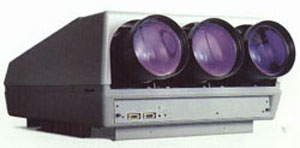
Barco Graphics 800
In about 1993 Barco came out with the
Barco 801. The 801 was very similar to
the 800, but had an extra circuit called AKB that compensates for picture tube
wear. Basically the same overall picture
as the Barco 800. ES focus on this set
as well. This set used the later version
07MSP tubes that were slightly sharper
than the 07MP tubes.
There are two versions of Barco 500 and
800 as well as other Barco models. There
are Graphics and Data models of most
projectors. The Data models use hybrid
lenses and do not scan as high as the
Graphics versions, which also have all
glass lenses. The Graphics are somewhat
more desirable, but in most cases the
scan rate of the Data projectors is more
than adequate for home theatre use.
The Data 500, 800 and 801 scan to 58
Khz, (line tripling), the Graphics scan
to 92 Khz.

Barco Data 701
In 1992 to 1994 Barco had a model called
the Barco 700 and 701. This was designed
more for the home market as the case was
small and very streamlined looking. 7”
Sony ES focus tubes, about 600-700
lumens, and scan rates varying from 36 Khz to 60 Khz depending on the model.
This unit had digital convergence, and a
very nice picture if the tubes are in
good shape. This model was not as
modular as other Barco modules,
requiring the projector to be sent in as
a whole when servicing was required.
A short while later the 701s was
introduced and upped the lumens rating
to 1000 and introduced component inputs.
The 708 is an even newer version still
which introduced some circuit
modifications and the IRIS
autoconvergence camera. . The Cine 7
replaced the 708 in about 1998. Again,
minor circuit changes were made, and
used a slightly better version of the
original Toshiba tube made by MEC. The
MEC tube is more expensive than the
Toshiba tubes, but held the focusing
ability for a longer period of time.
In late 1993 Barco introduced a new
series of video projectors, the 808,
1208, 1200, 1209, 1609, and 1101.
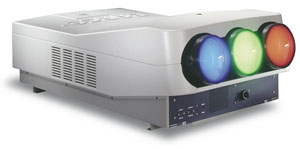
Barco Data 808s
The 808 and
1208 were 8” tubes with the improved EM
focus, the 1101, 1200 and 1209 used 9”
tubes with EM focus. Many of these
models also had Data and Graphics
models, with varying scan rates, and all
were rated at 1000 lumens or higher.
Digital convergence on all of these
models and lots of on screen menus.
Depending on the model and production run, the 808
either used Sony or MEC tubes. The MEC’s
are rebuildable and the Sony's are not.
The Sony tubes are at least $1400.00 USD
each to replace, the MEC’s can be
rebuilt for $600.00 USD each.
All of these sets give an excellent
picture and have been a popular seller
when I get them in.

Barco Cine 8
I get far fewer 9”
projectors in, but the 808 and 1208 are
usually in stock.
The Barco 808 was made until about 1998,
and has been replaced with the Cine 8. I have not worked
with these projectors as I have never
had any in on the used market yet. Very
high end projectors though.
The Barco 9” sets started with the
Graphics 1200. This set came out in 1993
and was in production until about 1995.
This set used the same Sony tubes as the
Sony 1292 and was razor sharp. The Sony
tubes are not rebuildable however
failure of this tube is rare. The Barco
1200 was a reliable chassis, and was
replaced by the 1609 and 1209 sometime
in 1995 or so.
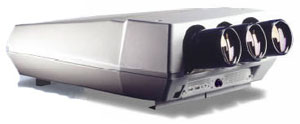
Barco Graphics 1209s
The 1209 and 1609 switched to MEC tubes,
the same tubes used in the Marquee 9XXX
series. These tubes are rebuildable, and
the 1209 had expanded software for more
control over the projected image.
The 1609 was a stripped down 1209 with
less software control than the 1209, but
the limitation of the 1609 was very
limited scan rates. The 1609 will scan
at 15 Khz (video), 32 Khz (line
doubling) and 64 Khz (line quadrupling).
The set therefore will not scan at 1080i
for HDTV or 720p which is line tripling.
The 1609 can be paired with a scaler
however such as the DVDO VP30 or the
Lumagen HDP to convert the input signal
to a scan rate that the 1609 can lock
to.
Barco strengths and weaknesses
In general, the Barcos have held up
very well, other than the 1XXX series as
noted above. Barcos are very modular,
and about 98% of the components can be
changed out without picking up a
soldering iron.
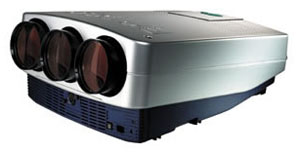
Barco Cine 7
Most Barcos have a
series of diagnostic lights within the
chassis that make it easy to narrow down
the problem area of a projector if it
fails. I have serviced and repaired many
Barco projectors via email or phone,
with about 80% of the projectors being
repaired the first time I send out
refurbished boards.
Barcos are known to develop bad solder
connections, specifically in the main
power supply area. The Barco 500, 800
have the unique problem that if
a certain solder connection fails on the
power supply, all three tubes can be
burnt instantly. Once the solder joint
is repaired however, the problem never
appears. I make a habit of resoldering
all solder connections prior to selling
these sets, and any power supply sent to
me for repair has all connections resoldered as well..
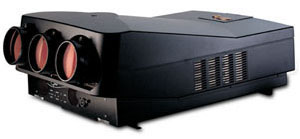
Barco Cine 9
Barco parts are insanely expensive from
Barco themselves, however thanks to the
large amount of projectors on the
surplus market, several resellers such
as myself have a large inventory of
rebuild modules and other parts in stock
at a fraction of the original purchase
price. I sell all parts on an exchange
basis; you send me back the defective
module so I can rebuild it and sell it
at a later date.
Barco projectors with digital
convergence are very easy to set up for
convergence, and the manuals are very
well written.
|
|









